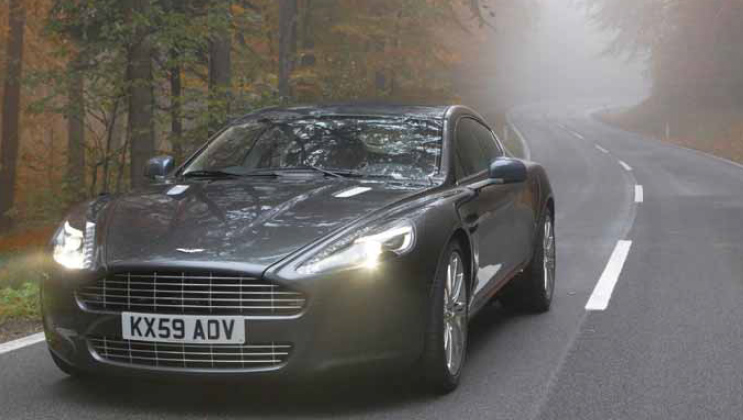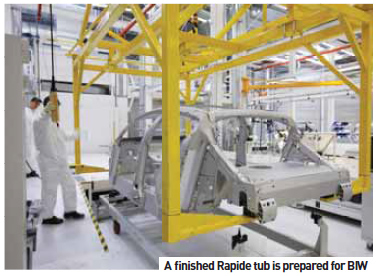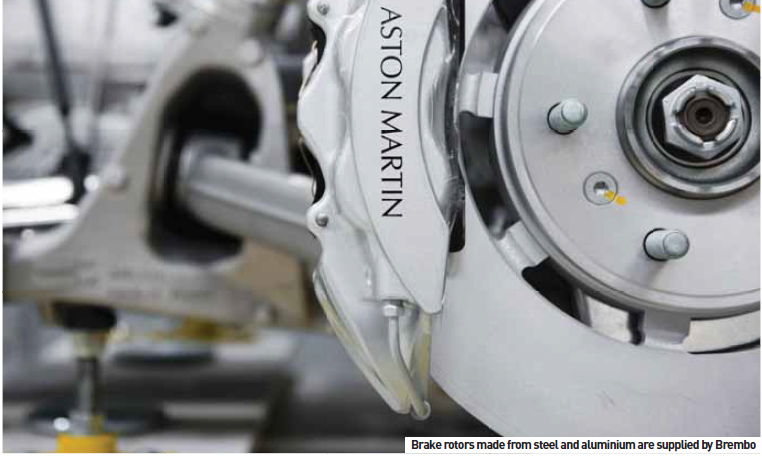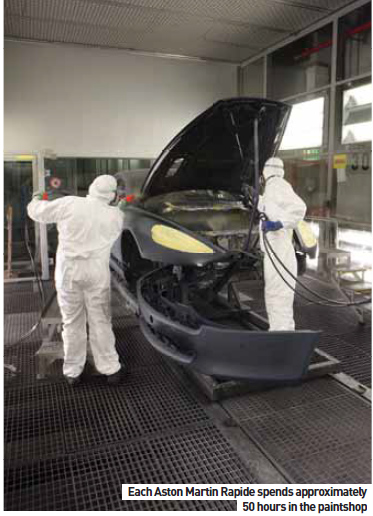
With Aston Martin’s Gaydon, UK facility nearing capacity, the carmaker has elected to work with Austria’s Magna Steyr for production of its Rapide fourdoor sports car.
"A year ago, this building was an empty shell. From January until now, we have transformed it into this.” Sean Parnell, Launch Manager for the Aston Martin Rapide is proud of his team’s achievement. The building in question, located in serial carmaker Magna Steyr’s complex outside, Graz, Austria, was formerly home to production of the Mercedes-Benz E-Class 4MATIC, a four-wheel drive estate model. All that remains from that is the renovated TMS conveyor, which now features a series of Aston Martin Rapide models in advancing stages of assembly. At first inspection, the Rapide looks like an extended DB9, but Parnell is quick to point out that the car was designed from the ground up to be a four-door model. As such, it’s hard to believe that it was only in 2007 (following the sale of Aston Martin by Ford) that shareholders gave Rapide production the green light.
Taking most of the build processes used at the new facility from Aston Martin’s Gaydon, UK production site has helped speed along the setup for Rapide production, though many of these have been adapted and improved by the combined team at Magna Steyr. In the UK, the area in which the aluminium tubs (chassis) are produced is closed to visitors in order to reduce particulate contamination. In Graz, the equivalent area is over-pressured to achieve the same goal. Before test production could begin, the hall was subjected to a thorough dust down. “It took about 10 days to get the place to the required level of cleanliness,” says Parnell. “We cleaned the place from top to bottom – and then did it again.”
The need to control particulates within the assembly hall goes back to the use of Betamate epoxy resin for joining the tub’s aluminium parts. “If you’ve got glue on a part, as soon as you get dust on the glue, you lose the perfect join. We have special cleaning products and lint-free cloths, because any spray that gets into the atmosphere can affect the product. We’re making sure that there’s no way dust can get into the area.” The glue itself is the result of intensive development. “We have about 150m of adhesive in the tub,” says Parnell. “Before we modified the adhesive product, we only had about four hours to build the tub - we have extended that to 24 hours.” A different type of glue is used to attach the exterior body panels, bringing with it a new set of challenges. “In BIW, we have about 14m of glue, but this product starts to cure at ambient temperature in about seven or eight minutes. We must frame all the sections within that time.”
The aluminium parts used to create the tub are supplied by a range of companies located in Hungary and the UK, with  each piece delivered in individual, dust-free packaging. As they are added to the tub structure, each part is first placed in a checking structure and scanned to ensure correct alignment, before glue is applied by ABB robots. Explains Parnell: “The robot measures the exact amount of glue that’s put onto the part. Anything that goes outside the tolerance bands programmed into the equipment sets off an alarm, so you know that you’ve got the correct level.”
each piece delivered in individual, dust-free packaging. As they are added to the tub structure, each part is first placed in a checking structure and scanned to ensure correct alignment, before glue is applied by ABB robots. Explains Parnell: “The robot measures the exact amount of glue that’s put onto the part. Anything that goes outside the tolerance bands programmed into the equipment sets off an alarm, so you know that you’ve got the correct level.”
Sean Parnell describes the reasoning behind the choice of glue as the preferred joining material. “If you weld two parts, you’re going to get a thin line. The (join) strength is going to be stretched across that thin line. If you use fixings, the strength is in each of those points. If you bond two pieces, you get a thick area of bond, with adhesive over the whole area – that whole area gives you strength. That means two things; left as is, you’d have a stronger structure. Otherwise, you can reduce the thickness of the material, while still retaining the join strength and making the vehicle lighter. We balance it, through design, the joining technology and the vehicle’s ideal weight.”
Oven ready
Using epoxy resin to bond the aluminium parts of the tub means that the curing of the adhesive is of critical importance. To ensure that each structure is cured correctly, Aston Martin’s Rapide production facility has developed a series of checks and crosschecks covering the complete production process, starting with the ovens.
The following companies supply the various aluminium parts used to create the tub chassis for the Aston Martin Rapide.
Hungary
SAPA
UK
Alumasc
Sarginsons
Superform
Panel Tech
Lotus Lightweight
Park Sheet Metal
Daventry Metal
Constructed by Sackl Anlagenbau, locally headquarted in Graz, the ovens include a series features to ensure the glue holding the aluminium tubs together receives the appropriate amount of heat. “The alarms in the oven work independently of the control systems, because you don’t want the control system to go wrong and be telling you you’ve got false readings, so you have to separate policing systems,” explains Parnell.
The pre-curing oven reaches a temperature of 130oC, and the main oven 180oC. As part of the failsafe tests, temperatures within each oven must be maintained for a predetermined period of time. Tests carried out within the oven outline the achieved temperature curve, with each tub having its own individual temperature report analysed after curing. In addition to this, once a week, a test tub fitted with monitoring equipment designed to analyse the temperatures achieved at over 150 points of the structure is run through the ovens. “Within a single tub, you’ve got large castings that have to absorb the same amount of heat in order to give you the right bond cure. Jets in the oven force air around it, resulting in a balanced heat all the way around the tub. This also means that if we want to change the cycle time, we have a lot more control.”
Any tub passing through the ovens and failing to meet all outlined criteria is scrapped, though Parnell says that the number of failures is rapidly falling as they advance through the various testing phases. “We had issues with the first few jobs, but we’ve achieved a level of stability now. It’s a new design, there were problem areas, but as we progress through each build phase I’m looking for different things.
“In the first build phase, we’re trying to prove out the (vehicle) design, and the design of the manufacturing facility. In the second build phase, what we’re currently going through, we’re fine-tuning the facility, improving the quality level. So we wouldn’t expect to see anything major after the first build phase. We’ve run 25, 30 vehicles through each of these build phases. Now, working two shifts, we’re trying to meet and exceed targets in BIW. The issue isn’t so much to do with strength; I did a lot of work on the tub and BIW design; the way these cars are built, they walk the tests. It’s more fit and finish, gap and flush.”
A further issue with curing of the adhesive was that of the steel dollies used to support the aluminium tubs. Explains Parnell: “As steel and aluminium expand at different rates, a fixed tub will push apart and lock in that position. So it’s all framed, 100% accurate, then we mono-bolt it into position; it’s basically floating on the pads. This way, the body is allowed to expand and contract naturally. It’s only held on by one pin, so the tub can expand around that, then come back.”
Fine tuning the product
Once cured, tubs are subjected to Point Inside Specific Tolerance (PIST) measurements. These read approximately 500 individual points on the finished structure, ensuring that the final product is within preset tolerances and alerting the team to areas of concern.
“We’ve developed a demerit system in conjunction with Magna,“ says Parnell. “If you have a tolerance of +/- 1mm, PIST will tell you that a given point is outside of the zone; it’s yes or no. Magna’s demerit system uses an exponential curve, so you’ll score one point if you’re within tolerance but away from nominal, then if you move 2mm away, you score four points. So you get a very high alert if you’re further away than you should be, there’s a massive difference. It’s a good system for alerting our engineers to problem areas.”
Once finished, the tub then has a series of silver, zig-zag pads added in key areas. Upon application to the metal surface, the pads contract, helping to dampen any vibrations that might occur. In areas of the tub, there is also a visible excess of adhesive, which is a deliberate addition, says Parnell: “We have areas where we want to see the readthrough from the joint, to tell us that we have a good bond.” While also ensuring a strong join, the additional adhesive helps to improve overall ride quality of the finished vehicle by sealing the body. Parnell says that fine-tuning application of the adhesive can reduce residual road noise and other ambient sound in the passenger compartment by closing air gaps in the in the car’s chassis. This is further improved with late-stage foaming operations and a post-sealing stage, carried out using a type of cold-cure adhesive.
Paint and final assembly
As the tub and BIW area is over-pressured, all personnel entrances feature sets of double doors, the inner door remaining
Major suppliers for the Aston Martin Rapide include:
Aston Martin Engine Plant (Cologne) Engines
ZF Transmission
Alcoa Wheels
Bridgestone Tyres
Bang + Olufsen Audio equipment
Brembo Brakes
Bridge of Weir Leather
Leoni Electrical harnesses
Lipik Door Glass
Recaro Seat frames
Valeo Headlamp
locked until the outer door is closed. As there is no joining bridge through which finished bodies can be conveyored to the paint shop, the team at Graz have developed a unique transport system. Parnell explains that once in position, the trucks moving the car bodies create a seal between the back the vehicle and the building. Only when this has been confirmed can the inner door be opened, allowing the car body (still on a dolly) to be moved into the vehicle. It’s a system that Parnell says was developed in-house, through to the conversion of the truck transporter. Paint facilities for Aston Martin are shared with other productin lines at Magna Steyr, but because of the temperature difference, the Rapide models have their own dedicated shift. “We’re running the paintshop at 80oC instead of 130oC,” says Parnell. “This is for two reasons. One is the glued aluminium body structure. The second is that the lower temperature allows us to achieve a superior finish. You can put an AM next to any other product and see the way that the (application) temperature and paint’s reaction with the materials results in a fantastic finish.”
Out of the 220 hours it takes to build each Rapide from start to finish, 50 hours of that is spent in the paintshop. Paint is applied both by hand and in an electrostatic transfer process, with equipment supplied by Durr. To ensure a perfect match between parts, all body parts are painted together, with clearcoat sprayed on and hand finished. The painted bodies are sent through to the trim and final area, which at the height of production will be producing between 40 and 50 cars per week working on one shift, with an annual output of 2,000 units. The instrument panel (IP) is fitted first, a key test of the tolerances to which the tub and BIW are constructed, says Parnell. “If I’m trying to fit an IP, tolerances are less than 1mm on either end. The crosscar beam is another bonded structure, so I’m building two independently bonded structures that have to be accurate to 1mm.”
For the four seats, frames are provided by Recaro and trimmed in Graz to customer specification. According to Parnell, the trim patterns in the seat covers had to be changed to accommodate the internal electronics. “Because of the electrical heating pads in the seat, we have to be very careful where the stitch patterns are positioned. put on the seat. We have to be sure not to sew or cut through the pad.” Integration of the rear LCD screens evidently caused problems, due to crash testing and possible head impacts. This was solved by recessing the screens within the seat cover material.
One of the most innovative features of the Rapide’s underbody architecture are the brake rotors, formed from a combination of aluminium and steel. Parnell explains that the lightweight discs, manufactured by Brembo, feature a steel outer ring that has teeth machined into the inner rim, that subsequently has an aluminium hub cast into the centre. The teeth allow for the different expansion rates of the two metals. “As far as I’m aware, we’ll be the first company to offer this type of brake,” says Parnell.
Machined from a solid block of billet aluminium, the Cube will be the heaviest Rapide ever made. Weighing at approximately 4,000kg, it is an exact representation of the car, which will be used to verify part accuracy. “This is the closest you can get to accurate,” says Sean Parnell, Launch Manager for the Aston Martin Rapide. “Before, when there was a problem on the line with something not fi tting, you’d be guessing whether it was the body or the part that was at fault – and the part would get shipped away for inspection, etc. Now, we can drop the part onto the body, measure all the gaps and fl ushes around the part, and quickly understand whether it’s the part or the body at fault.” Manufactured in the UK and shipped out to Graz, Parnell politely declines to reveal how much the Cube cost to fabricate. There’s no doubt, though, that it’ll recoup its value when it comes to quickly determining which element of the car is at fault.
The windows are also unique to this Aston Martin. “The pillarless, frameless doors are one of the more difficult elements of the car to build,” explains Parnell. “There are three independent pieces of glass (on each side) working together to seal the car in three stages. When the door is opened, the glass (including the quarter light) drops down. When the door is closed, it goes to a step two stage, closing the gap. Once the car reaches about 40mph, it goes to step three and the glass fully engages, bedding deep into the seal.” In most vehicles, should something be trapped in a closing window, the motor would sense the additional stress and automatically wind down. In the Rapide, the scissor-like action of the closing glass makes this unfeasible, so a sensor strip is embedded in the window seal to check for trapped objects and unwind the windows. “From a safety aspect, it’s all linked together through the crash sensors,” adds Parnell. “If the car is in an accident, all the glass drops so passengers can get out of the car.”
Currently, every car coming off the production line is subjected to a series of tests in the ‘Quality Centre’. “We’re checking every single item on every single vehicle, but as we grow more confident, we’ll reduce the number of vehicles going in here. When we enter production, all the cars will be tested, but only one car per will day will be audited. We’re down to fit and finish on some of the vehicles where we’re looking at less than 1mm panel gaps on areas of the car.” This includes the gap between the rear door and quarter panel. Owing to the way the body flares out towards the viewer, the panel gap between these two body elements has been narrowed in places to give the illusion that the gap is the same width all the way along. Parnell says that it’s elements like this that make the Rapid one of the most difficult cars in the world to produce.
First four-door since Lagonda
All Aston Martin models are produced in essentially the same way, using what is referred to as the company’s ‘vertical horizontal structure’. This essentially means that from the smallest model, the Vantage, through to the largest, the Rapide, every car features the same underlying construction methodology.
 “Although it’s the same basic architecture as the DB9, the major difference is the overall size, as well as the size of some of the components, to give it length and structure,” says Sean Parnell. “If you take the DB9 when it first entered production and look at the 400 model as it is now, the joints have changed to give better process and better results.” The fact that the Rapide has been designed from the ground up to be a four-door car has brought its own set of unique problem to a company renowned for building twodoor sports cars. “It’s a lot harder to meet legislation on a four-door model. The strength of the B-pillar is critical.” The B-pillar is one of various parts in the structure of the Rapide made from superformed aluminium, though the only one arranged in a box section. “Superforming gives you a lot more flexibility than you can get out of a press, but the issue is the volume of production and the time it takes to produce a part. Where possible we prefer to press a part, but in places like the B-pillar we’ve had to use superforming to get the required results, the strength point and also so the shaping.” Parnell goes on to explain that there are added complexities to overcome with the Rapide being a ‘world car’ and the need to meet various safety testing criteria. As an example, he cites Canada’s legislation for bumper impacts. According to Canadian law, when a car’s bumper is hit at 7mph (10km/h), there can be no damage to the vehicle beyond the bumper assembly; if the structure is affected past the crash barrier, the car fails the test. As such, the rear lip of the Rapide had to be redesigned so as not to be affected by this type of impact. Parnell says that to avoid issues with local legislation, the Rapide has been designed to pass the most stringent of local tests in any given country.
“Although it’s the same basic architecture as the DB9, the major difference is the overall size, as well as the size of some of the components, to give it length and structure,” says Sean Parnell. “If you take the DB9 when it first entered production and look at the 400 model as it is now, the joints have changed to give better process and better results.” The fact that the Rapide has been designed from the ground up to be a four-door car has brought its own set of unique problem to a company renowned for building twodoor sports cars. “It’s a lot harder to meet legislation on a four-door model. The strength of the B-pillar is critical.” The B-pillar is one of various parts in the structure of the Rapide made from superformed aluminium, though the only one arranged in a box section. “Superforming gives you a lot more flexibility than you can get out of a press, but the issue is the volume of production and the time it takes to produce a part. Where possible we prefer to press a part, but in places like the B-pillar we’ve had to use superforming to get the required results, the strength point and also so the shaping.” Parnell goes on to explain that there are added complexities to overcome with the Rapide being a ‘world car’ and the need to meet various safety testing criteria. As an example, he cites Canada’s legislation for bumper impacts. According to Canadian law, when a car’s bumper is hit at 7mph (10km/h), there can be no damage to the vehicle beyond the bumper assembly; if the structure is affected past the crash barrier, the car fails the test. As such, the rear lip of the Rapide had to be redesigned so as not to be affected by this type of impact. Parnell says that to avoid issues with local legislation, the Rapide has been designed to pass the most stringent of local tests in any given country.
“Obviously, you’re building a car for tests that are used on all cars and you can’t expect every car to be a small hatchback. We build to pass standardised tests, but then our (in-house) tests our more rigorous than most. Eighty-five per cent of all Astons are still on the road, and I like to think that in 30 years, this car will still be as safe as it is today.” The speed at which the combined teams from Magna Steyr and Aston Martin have developed and implemented production processes for the new Rapide is phenomenal, particularly when taking into consideration that each car is constructed with up to five thousand individual parts. In just over two years, from project sign off in 2007, the first customers for the Rapide will be taking delivery of their cars. Sean Parnell, with a small team from Aston Martin, will remain in Graz, though production will be carried out by the approximately 240 Magna technicians.
“I think it’s great for the two companies,” says Sean Parnell. “For Magna, we’ve come in with our knowledge and understanding, but we’ve also learned different ways to work from Magna, which have been fed back to Gaydon. It’s a stepped improvement for both companies.”


































